«previous pageGENERAL DESIGN CATEGORY
Honor Award
Teardrop Park, New York, NY
Michael Van Valkenburgh Associates, Inc., New York, NY
client: The Hugh L. Carey Battery Park City Authority
Project Statement:
Teardrop Park transcends its small size, shady environment, and mid-block urban location through a meandering design formed with complex irregular spaces, robust plantings, strong materials and bold topography that creates places for prospect and refuge. Designed primarily as a landscape for children, the park's spatial structure and reinterpretation of natural form makes a place for exploration and movement.
Project Narrative:
Project Location, Scope and Size
Teardrop Park is a 1.8 acre public park located in Battery Park City, a mixed-use neighborhood on the southwestern side of lower Manhattan. The landscape architects were the prime consultant, responsible for organizing the project team and overseeing design from initial concept through construction administration. The park's design and construction was coordinated by the landscape architects with that of the four surrounding apartment buildings, creating opportunities to fine-tune architectural massing as a means of improving site environments. In addition to engineers and lighting consultants, contributing subconsultants included child development specialists, soils engineers, and a fountain designer.
Physical Context
The flat, featureless plot of land that was the pre-existing site was created in the 1980s by filling in a portion of the Hudson River shoreline. This resulted in a high water table and potential for lateral infiltration of river waters that limited the potential depth of site program. Solar analysis indicated that the residential towers that were to define the corners of the park, each ranging from 210 feet to 235 feet in height, would create tremendous shade.
Wind studies indicated that the east/west corridors through the park would experience strong, cold, and desiccating winds off the Hudson River while the areas between the buildings would be more protected.
The combined constraints of water, sun, and wind affected how park program was positioned as well as the kinds of plant and ecological communities that could be created. For instance, recognizing that the northern half of the site would have the longest hours of sunlight on any given day, the designers made this the location for the Lawn Bowl (which was tilted southward to better absorb the available light). Play areas for small children, like a sand box, Slide Hill, and Water Play rocks, were placed in the shaded and wind-protected areas.
Design Program
The client wanted a unique natural environment for play that would build on nearby recreational opportunities, contribute to the ongoing development of a family-friendly social identity for the neighborhood, and meet the client's own strict sustainability guidelines. Although children were imagined as the most important users, the park was to provide a landscape setting that appealed to multiple age groups represented in the neighborhood. The range of users includes students from a nearby high school, office workers, residents of the hundreds of surrounding apartments, and elderly residents of an adjacent assisted-care facility. Specific client program directives included sand and water play areas and a lawn that would be large enough for periodic events, but most importantly, would provide alternative and more passive forms of play in response to the huge traditional play equipment at nearby Rockefeller Park.
Design Intent
Experiencing natural environments is widely recognized as an important part of early childhood development, and yet most urban playgrounds have banished plants in favor of equipment. Teardrop Park is designed to address this gap, offering adventure and sanctuary to urban children while engaging their minds and bodies. Site topography, interactive water fountains, natural stone, and intimately-scaled plantings contribute to an exciting inner world of intricate textures, intense scale differences, and precisely choreographed views.
Specific features, like the Ice-Water Wall, the Marsh with its access path scaled to children, the steeply sloped planted areas, groves of trees, and the Water Play rocks, as well as the stone Reading Circle placed where there is also an outward view to the Hudson River, celebrate the expressive potential of the natural materials of landscape construction while reinventing the idea of nature play in the city.
Environmentally Sustainable Materials and Installation Methods
The client's design review panel was an active force in the early development of the design, offering key support as the landscape architects navigated through complex programmatic and technical decisions related to achieving ambitious sustainability goals and a generally innovative design strategy.
The park's "green" credentials are reflected in every aspect of its development, from material selection to contractor practices. Not only is the park layout and program a response to the microclimatic asymmetry created by the buildings; the varied fabricated soils were also meticulously calibrated to create optimum growing conditions.
Based on decades-long research into urban soils and non-toxic plant maintenance, environmental aspects of the park's design include fully organic manufactured soils and maintenance regimes that avoid pesticides, herbicides, or fungicides. Treated and recycled gray water from the adjacent LEED Gold-rated Solaire Building and stormwater runoff from the site captured in an underground storage pipe supply all of the park's irrigation needs.
Throughout the park, including the 27-foot high, 168-foot long stacked blue stone Ice-Water Wall, stone selection was limited to those that could be quarried within 500 miles of the park site. The largely native plant palette creates excellent habitat for migrating birds and effectively jump-starts natural ecologies on a site that is composed of biologically inert fill from the original excavation of the World Trade Center. A calibrated approach to soils allowed the landscape architects to match carefully inventoried microclimates with several variations of the manufactured soil.
Project Resources
Client
The Hugh L. Carey Battery Park City Authority, New York, NY; Battery Park City Parks Conservancy, New York, NY
Landscape Architects
Michael Van Valkenburgh Associates, Landscape Architects, New York, NY : Cambridge, MA
Artists
Ann Hamilton, Columbus, OH
Michael Mercil, Columbus, OH
Play Consultant
Natural Learning Initiative, Raleigh, NC
Lead Engineer
ARUP, New York, NY
Geotechnical Engineer
Rutledge Consulting Engineers, New York, NY
Lighting Designer
Cline, Bettridge, Bernstein Lighting Design, New York, NY
Turf Consultants
A. McNitt Consulting, Pennsylvania State University
Agronomy Department
Park, PA; John Stier, University of Wisconsin, Madison, WI
Fountain Designer
R. J. Van Seters Company,
Unionville, ON
Soil Scientist
Pine and Swallow Environmental, Groton, MA
Irrigation Consultant and Designers
Northern Designs, North Haven, CT
Architectural Lighting Consultants
U:Lighting, New York, NY
Natural Light Consultants
Carpenter Norris Consulting, New York, NY
James Carpenter Design Associates, New York, NY
Quarry/Stone Consultant
New York Quarries, Alcove, NY
Onsite Masonry Oversight
Betsy Hoffman,
Hayden Hillsgrove,
North Sandwich, NH
Featured Products
Benches
Kenneth Lynch & Sons
Poured-in-Place Play Surface
Sureplay International
Pavers
Hanover Architectural Products
Pole Lights
BEGA/US Architectural Lighting Fixtures and Products
Drinking Fountain
Tri Palm International, LLC
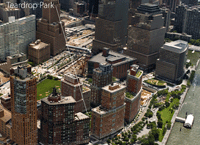
Teardrop meets the city sidewalk with an outward image of robust naturalism and public accessibility. Direct walk-through paths combine with a system of secondary internal loops that feed into a complex network of spaces. (Photo: Alex MacLean, Landslides Aerial Photography)

(Photo: Elizabeth Felicella)
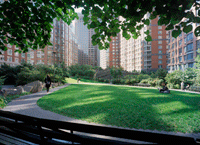
Looking south down the tilted Lawn Bowl towards the Ice-Water Wall. Through topographic variation, borrowed views and meandering pathways, the park achieves spatial range and depth. (Photo: Paul Warchol)

The naturalistic imagery and openness of Teardrop's central Lawn Bowl creates strong urban juxtapositions and opportunities for landscape escape within the architectural immediacy of the four surrounding residential towers. (Photo: Elizabeth Felicella)
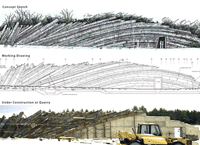
Diagram of designing and constructing the Ice-Water Wall. At full scale, the stone layers were composed at the quarry to maximize opportunities to fine-tune the stone selection. The wall was then disassembled, numbered, and reassembled onsite in New York City. (Photo: MVVA)

The Ice-Water Wall simultaneously suggests and reinterprets the geology of New York state. The individual pieces of Alcove bluestone (technically a thick veneer), retain their natural shape, color, and surface irregularity. Recessed black mortar helps establish solidity. (Photo: Adrian Marshall)
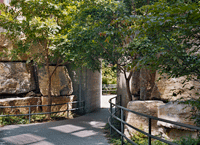
A pathway lined with stacked limestone and small trees leads to a concrete tunnel that emerges through the Ice-Water Wall, revealing a view up the Lawn Bowl. Teardrop Park expresses human construction alongside naturalism, encouraging a dialogue between the two. (Photo: Elizabeth Felicella)
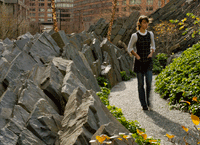
Looking up the ramped path to the Reading Circle between a segment of the Geologic Section (left, by the artist) and Hellebore Hill (right). (Photo: Paul Warchol)
"A true urban oasis. The landscape architect has made a very bold gesture on an almost impossible site. It offers intimacy, which is tough for a public park, and takes your mind away from the city and surrounding buildings. It works for all ages."
— 2009 Professional Awards Jury
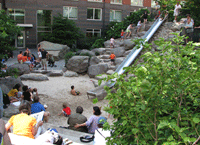
The 14-foot long custom-made stainless steel slide, rested on the side of a bowled land form, and the Wooden Step Seats (foreground) create a social microcosm shared by sliders, climbers, onlookers, diggers, and New York Times readers. (Photo: Nilda Cosco, Natural Learning Initiative, College of Design, NC State University, Raleigh, NC)
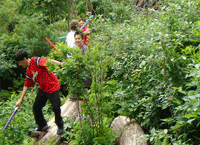
The Marsh. Lush vegetation with the wildlife it supports create an environment of open-ended play and endless discovery. The Marsh is fed by carefully directed surface site runoff and manufactured soils to retain moisture. Narrow passage is scaled for children. (Photo: Elizabeth Felicella )
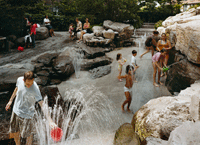
Water Play. Within an interior circulation of play circuits, Teardrop Park creates the conditions for children's play that feels far removed from traffic and ordinary street life. Children are able to turn the water on and off. (Photo: Elizabeth Felicella)
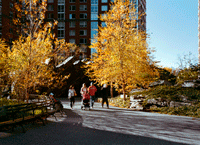
View west through the park from North End Avenue. Typical New York City park elements and paving combine with atypical natural features to make Teardrop Park immediately recognizable as a public park. (Photo: Elizabeth Felicella)

(Photo: MVVA)

(Photo: Paul Warchol)
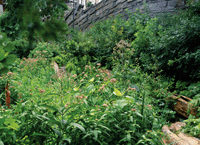
(Photo: Paul Warchol)



